A Visible Church: 1843-1903
Catholicism manifests itself in words and deeds of charity, in care for the poor and helpless, in education for children and adults, and also in brick and mortar. The presence of the Catholic Church in any community can often be seen by examining the skyline. Church steeples vault into the air, large portions of urban or rural ground are set aside for churches, residences for clergy and sisters, hospitals, social welfare institutions (orphanages, rest homes for the elderly, youth centers). In these locations, Catholics believe, men and women see the face of God. As John Gurda has observed: “On the indeterminate border between theology and sociology stands the parish church. Catholicism is a universal system of belief that applies across all borders and in every time, but this cosmic faith comes to life, always in minutely, particularly human circumstances---this community and not another, this street corner and not the next. Each parish church is, in essence, a fresh incarnation, the universal faith made flesh and blood, or at least brick and mortar.”
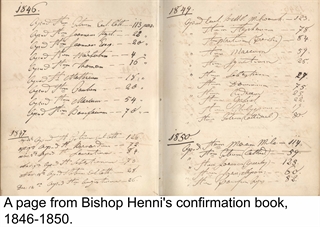 Bishop (later archbishop) John Martin Henni (1805-1881) and his co-workers began their efforts in 1844 to raise the institutional visibility of the Catholic Church in the growing territory/state of Wisconsin. They invested millions of dollars (often raised from European Catholics), even more human energy, and prayer to erect a sturdy infrastructure for the vital work of ministry: praising God, educating the ignorant, caring for the sick, preparing priests and religious, and helping those in need. Bishop Henni and others wrote letters describing life in the new diocese to the Ludwigs-Missionverein, a Bavarian society founded to support missionary activity in the United States.
Bishop (later archbishop) John Martin Henni (1805-1881) and his co-workers began their efforts in 1844 to raise the institutional visibility of the Catholic Church in the growing territory/state of Wisconsin. They invested millions of dollars (often raised from European Catholics), even more human energy, and prayer to erect a sturdy infrastructure for the vital work of ministry: praising God, educating the ignorant, caring for the sick, preparing priests and religious, and helping those in need. Bishop Henni and others wrote letters describing life in the new diocese to the Ludwigs-Missionverein, a Bavarian society founded to support missionary activity in the United States.
Two critical buildings stand at the forefront: the Cathedral of St. John and St. Francis de Sales Seminary. Henni’s first “cathedral” was the humble church of St. Peter’s on Martin Street built by Father Patrick O’Kelly of Detroit. In 1847, Henni purchased land directly across from the Milwaukee County Courthouse (today Cathedral Square) and laid the cornerstone for a new cathedral. He secured the services of Victor Schulte, a Pennsylvania architect who designed not only the cathedral, but also St. Francis de Sales Seminary. Done in a federal style, the church initially sported a distinctive bulb dome, familiar to churches in Europe. It took a long time to finish the cathedral, as building funds had to be regularly replenished. Henni took tours abroad (even to Cuba) to beg for funds. In 1852, Archbishop Gaetano Bedini, a nuncio from Brazil, dedicated St. John the Evangelist Cathedral.
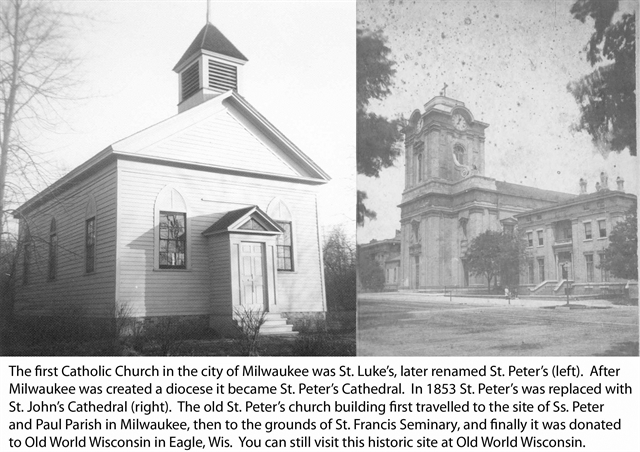

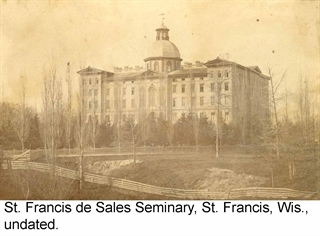 On his trip, Bedini also visited the sight of the future St. Francis de Sales Seminary on the south shore of Milwaukee. Here Schulte designed a majestic domed building that added two wings in later years. St. Francis de Sales Seminary would become an important element of the growth of the Catholic Church and the entire Midwest. For many years, St. Francis was known as a German seminary, catering primarily, but not exclusively, to German speaking men who desired to become priests. Father (later bishop) Michael Heiss (1818-1890) was the first rector.
On his trip, Bedini also visited the sight of the future St. Francis de Sales Seminary on the south shore of Milwaukee. Here Schulte designed a majestic domed building that added two wings in later years. St. Francis de Sales Seminary would become an important element of the growth of the Catholic Church and the entire Midwest. For many years, St. Francis was known as a German seminary, catering primarily, but not exclusively, to German speaking men who desired to become priests. Father (later bishop) Michael Heiss (1818-1890) was the first rector.
In Milwaukee and elsewhere the Church sought to build strong, homogeneous communities that replicated the strengths of German-speaking Catholicism in Europe. The first four bishops of Milwaukee were all German speakers: Henni from Switzerland, Michael Heiss from Bavaria, Frederick X. Katzer from Austria, and Sebastian Messmer from Switzerland. Milwaukee was an important center for German settlers, part of the famous “German Triangle” of Midwestern cities: Cincinnati, St. Louis, and Milwaukee. German Catholics linked the preservation of the faith with the German tongue (“language preserves faith”). Aided with generous benefactions from missionary societies in Germany, Austria, and France, German churches were elaborately decorated and outfitted and placed a high value on quality church music. German choir masters like John Singenberger (1848-1924) trained a generation of church musicians for Milwaukee. Community singing, public processions, and devotions to the saints and Mary were a significant part of the German Catholic experience.
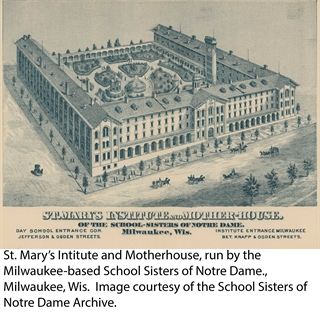 Religious orders of women came to minister to these German speakers, many of whom established large motherhouses in Milwaukee. These included the Schools Sisters of Notre Dame (and their influential superior Mother Caroline Friess (1824-1892), the School Sisters of St. Francis, the Franciscan Sisters of Penance and Charity, the Sisters of the Divine Savior, and the Racine Dominicans.
Religious orders of women came to minister to these German speakers, many of whom established large motherhouses in Milwaukee. These included the Schools Sisters of Notre Dame (and their influential superior Mother Caroline Friess (1824-1892), the School Sisters of St. Francis, the Franciscan Sisters of Penance and Charity, the Sisters of the Divine Savior, and the Racine Dominicans.
Other religious created a network of health care and social welfare agencies. The Daughters of Charity opened St. Mary’s Hospital and St. Rose Orphanage in Milwaukee. The Sisters of St. Agnes opened schools and a hospital in Fond du Lac and its environs. The School Sisters of St. Francis opened Sacred Heart Sanitarium and St. Mary’s Hill Hospital. The Franciscan Sisters worked in St. Aemillian’s Orphanage on the seminary grounds and helped found a school for the hearing impaired.
In 1868, diocesan boundaries were divided in Wisconsin to create the dioceses of La Crosse and Green Bay. In 1875, Blessed Pius IX elevated Milwaukee to the status of an archbishopric.
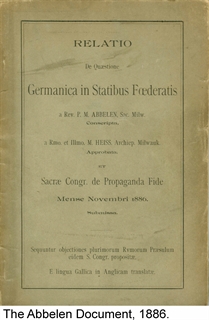 In 1881, Archbishop Henni passed to his reward. After a bit of struggle among the priests, Michael Heiss became the second archbishop of Milwaukee. He helped stabilize archdiocesan finances and create clearer administrative structures for the local church. He was succeeded by Frederick X. Katzer (1844-1903) in 1891. Katzer had served at St. Francis Seminary and was elevated to the diocese of Green Bay. Both Heiss and Katzer’s terms were eras of steady growth but also of national controversy over the perpetuation of German identity in the parishes. Pressures to use English in school and official business began to grow. Both Heiss and Katzer found themselves at odds with other American bishops like John Ireland of St. Paul and James Gibbons of Baltimore over these ethnic issues. Milwaukee priests like Father Peter Abbelen, a chaplain to the School Sisters of Notre Dame, waded into the public controversy by his insistence on the preservation of German ethnicity.
In 1881, Archbishop Henni passed to his reward. After a bit of struggle among the priests, Michael Heiss became the second archbishop of Milwaukee. He helped stabilize archdiocesan finances and create clearer administrative structures for the local church. He was succeeded by Frederick X. Katzer (1844-1903) in 1891. Katzer had served at St. Francis Seminary and was elevated to the diocese of Green Bay. Both Heiss and Katzer’s terms were eras of steady growth but also of national controversy over the perpetuation of German identity in the parishes. Pressures to use English in school and official business began to grow. Both Heiss and Katzer found themselves at odds with other American bishops like John Ireland of St. Paul and James Gibbons of Baltimore over these ethnic issues. Milwaukee priests like Father Peter Abbelen, a chaplain to the School Sisters of Notre Dame, waded into the public controversy by his insistence on the preservation of German ethnicity.
The medley of ethnic groups that responded to the need for industrial workers in the Midwest - Bohemians, Slovaks, Poles, and Italians - found their way into the archdiocese. The local church accommodated them with national parishes and priests to serve their needs.
By Rev. Steven M. Avella
Photographs and documents courtesy of the Archdiocese of Milwaukee Archives, unless otherwise noted. Photographs and documents cannot be reproduced without prior written authorization. For permission to reproduce contact the archdiocesan archives.